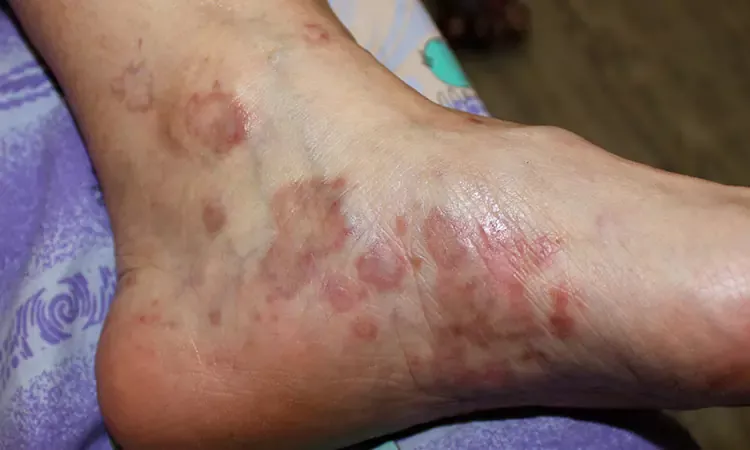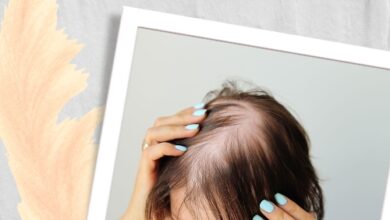Lichen Planus Symptoms, Causes, Diagnosis and Treatment

What Is Lichen Planus?
Lichen planus (like-en play-nes) is a skin condition that causes a rash to develop on one area of your body or several parts of your body at the same time. It can affect your:
- Skin.
- Inside of your mouth (oral mucosa).
- Scalp (skin on your head usually covered with hair).
- Nails.
- Genitals (penis, vagina and vulva).
Lichen planus is a lichenoid dermatoses. Healthcare providers use the term used to characterize skin disorders according to the presence of firm, raised, discolored bumps on your skin.
Is lichen planus an autoimmune condition?
Lichen planus isn’t an autoimmune condition, but it can cause a similar response. It’s an idiopathic (meaning the cause is unknown) condition that causes inflammation in your skin. In lichen planus, your body’s immune system attacks parts of your body instead of protecting your body from foreign invaders like bacteria or viruses.
In a healthy immune system, special cells in it called T cells help protect your body from infection. In people with lichen planus, their immune system’s T cells attack a protein in their skin and mucus membranes.
No one knows why the T cells attack the protein.
What is the difference between lichen planus and lichen sclerosus?
Lichen planus and lichen sclerosus are both idiopathic conditions that affect your skin, especially mucus membranes.
Lichen sclerosus is a long-term skin condition that causes your skin to gradually become thinner, itch, develop sores and eventually scar. It can occur anywhere on your skin, but it mainly affects the skin around your genitals and anus (anogenital region). You’re more likely to have it if you’ve gone through menopause.
The difference between lichen planus and lichen sclerosus is that lichen sclerosus rarely affects the mucous membranes in your mouth.
What’s the difference between lichen planus and psoriasis?
Lichen planus and psoriasis are both skin conditions that can cause discolored rashes. The main difference between lichen planus and psoriasis is that psoriasis is scaly and typically won’t affect the inside of your mouth.
Who does lichen planus affect?
Anyone can get lichen planus. However, you’re more likely to develop it if you’re a female between 30 and 60 years old.
Some studies suggest that females get lichen planus twice as often as males, and they’re more likely to develop it in their 60s. Males are more likely to develop it in their 40s.
If you have lichen planus on your skin, you’re 50% to 75% more likely to have it in your mouth.
How common is lichen planus?
Lichen planus affects approximately 0.22% to 1% of the adult population. Oral lichen planus affects 1% to 4% of the world population.
How does lichen planus affect my body?
Lichen planus commonly affects the skin around your wrists and elbows (flexor surfaces), the back of your hands (dorsal surfaces) and the fronts of your lower legs.
About half of all people who have lichen planus develop oral lichen planus, which affects the skin inside of your mouth and your tongue.
The affected spots (lesions) on your body usually start as tiny, raised dots (papules) that are about the size of the tip of a pin (0.4 millimeters [mm]). They may grow up to the width of a pencil (1 centimeter [cm]).
Oral lichen planus typically starts as tiny white dots on the skin inside of your cheeks or your tongue. In severe cases, the surrounding skin may become inflamed, and sores may develop.
What Are The Symptoms Of Lichen Planus?
The symptoms of lichen planus tend to vary, depending upon the affected body area, commonly, lichen planus affects the following:
- PENIS:
1. White or purple patches on the glans.
2. Shiny bumps and non-itchy rash. - MOUTH:
1. White pattern in your inner cheeks and tongue.
2. Painful gums.
3. Dry mouth.
4. Metallic taste.
5. White and red patches in your mouth. - SKIN:
1. Reddish-Purplish bumps.
2. These raised bumps have a flat top.
3. Affected skin can cause itching.
4. The condition usually affects the lower back, ankles and wrists. - VAGINA AND VULVA:
1. Rawness and soreness around your vulva,
2. Yellow discharge,
3. Formation of scar tissue,
4. Painful intercourse,
5. Vulva can be surrounded by a pale white, pink or red color streaks.
What Causes Lichen Planus?
The following may cause lichen planus flare-ups:
- Hepatitis C.
- Vaccines.
- Nonsteroidal anti-inflammatory drugs (NSAIDs).
- Particular medications used to treat arthritis, heart disease or high blood pressure.
- Particular chemicals, metals or pigments.
What Are The Risk Factors Of Lichen Planus?
Certain factors identified for increasing one’s chances of lichen planus include:
Diseases for example hepatitis C.
- Exposure to dyes, medicines and certain chemicals.
- Middle-aged adults are more likely to develop lichen planus.
What Are The Potential Complications Of Lichen Planus?
Few complications lichen planus can lead in the future include:
- Oral cancer.
- Hair loss.
- Sexual dysfunction.
- Squamous cell carcinoma.
How Is Lichen Planus Diagnosed?
Your healthcare provider can typically diagnose lichen planus after assessing your symptoms and conducting a physical exam. They may look for characteristics known as the “six Ps” that help diagnose lichen planus:
- Pruritic (They’re itchy).
- Polygonal (Your rash shape has many sharp angles).
- Planar (The top is flat).
- Purple papules (bumps).
- Plaques (raised, discolored, patches).
If there’s any doubt, your healthcare provider may perform the following tests:
- Allergy test. An allergy test can determine if you have an allergy that’s causing your lichen planus flare-up.
- Biopsy. Your healthcare provider will use a thin blade (scalpel) or a punch tool to collect a small sample of skin from your rash. Your skin sample goes to a laboratory for testing and pathologists examines it under a microscope.
- Hepatitis C test. Lichen planus is sometimes associated with the hepatitis C virus.
How Is Lichen Planus Treated?
There isn’t a cure for lichen planus. If you have lichen planus on your skin, in most cases, it goes away without treatment in as little as a few months to several years.
The following treatments may help relieve your symptoms:
- Corticosteroid creams or ointments. Your healthcare provider may prescribe corticosteroid creams or ointments to reduce inflammation.
- Antihistamines. Antihistamines are a class of drugs commonly used to treat allergy symptoms, including itchy skin.
- Phototherapy. Phototherapy uses ultraviolet light, usually ultraviolet B (UVB), from special lamps. The ultraviolet light waves found in sunlight can help certain skin disorders, including lichen planus.
- Immunosuppressants. Medications that lower your immune system such as oral corticosteroids, mycophenolate mofetil, azathioprine or cyclosporine can be helpful.
- Retinoids (vitamin A derivatives). Retinoids are a pill or ointment that help your body produce more collagen and blood vessels, which can help your rash. Retinoids may cause birth defects, so it’s a good idea to check with your healthcare provider if you’re pregnant or planning to become pregnant.
If you have lichen planus in your mouth, in most cases, it goes away within five years. If you experience irritation or sores, you can help alleviate your symptoms by:
- Practicing good oral hygiene. Regularly brush and floss your teeth, and get your teeth professionally cleaned by your dentist at least twice a year.
- Minimize injuries (trauma). Injuries to your mouth can increase the severity of your sores, as well as how often flare-ups occur. Gently brush your teeth, put dental wax around braces or orthodontic wires and consider removing any piercings that bump or rub against the inside of your mouth.
- Replacing dental fillings. Though rare, some people have allergies to the mixtures of different metals (amalgams) used in tooth fillings. These allergic reactions may look similar to lichen planus. Replacing amalgam fillings with a hypoallergenic material that won’t cause an allergic response may improve your irritation or sores.
Are there any home remedies for symptoms of lichen planus?
There are several over-the-counter products or home remedies that can help stop your rash from itching.
While Herbal Remedies for Lichen Planus are safe for most people, it’s a good idea to check with your healthcare provider before trying some of the following options. You may be at risk of developing an allergic reaction.
- Aloe vera. Aloe vera is a wound care gel that can moisturize, heal and treat sores. Some research suggests that it can relieve lichen planus symptoms in your mouth or on your vulva.
- Antihistamines. Antihistamines are a class of drugs commonly used to treat allergy symptoms, including itchy skin.
- Hydrocortisone creams or ointments. Over-the-counter (OTC) hydrocortisone is a corticosteroid combined with an anesthetic pain reliever.
- Oatmeal: The best way to use oatmeal on your lichen planus skin rash is to grind it into a fine powder (colloidal oatmeal) in a blender or food processor. Mix the oatmeal powder with warm water until it becomes a thick, sticky paste. Apply enough of the oatmeal paste to cover your rash completely. After at least 10 minutes, wipe off the paste with a clean towel.
Stress can also make skin disease worse. There are mental/emotional signs of stress and physical signs of stress. Stress management techniques can help you prevent or ease your stress-induced lichen planus symptoms.
Reference: https://my.clevelandclinic.org/health/diseases/17723-lichen-planus
Related Articles :
Ecthyma Symptoms, Causes, Diagnosis and Treatment
Diaper Dermatitis Symptoms, Causes, Diagnosis and Treatment
Chronic Lymphocytic Leukemia Symptoms, Causes, Diagnosis and Treatment
Bartonellosis Symptoms, Causes, Diagnosis and Treatment
Pruritus Symptoms, Causes, Diagnosis and Treatment
Measles Symptoms, Causes, Diagnosis and Treatment
Keratosis Pilaris Symptoms, Causes, Diagnosis and Treatment
Impetigo Symptoms, Causes, Diagnosis and Treatment
Idiopathic Thrombocytopenic Purpura Symptoms, Causes, Diagnosis and Treatment
Ichthyosis Vulgaris Symptoms, Causes, Diagnosis and Treatment
Seborrheic Keratosis Symptoms, Causes, Diagnosis and Treatment
Scleroderma Symptoms, Causes, Diagnosis and Treatment
Porphyria Symptoms, Causes, Diagnosis and Treatment
Polycythemia Vera Symptoms, Causes, Diagnosis and Treatment
Hidradenitis Suppurativa Symptoms, Causes, Diagnosis and Treatment
Hyperhidrosis Symptoms, Causes, Diagnosis and Treatment
By : Natural Health News




